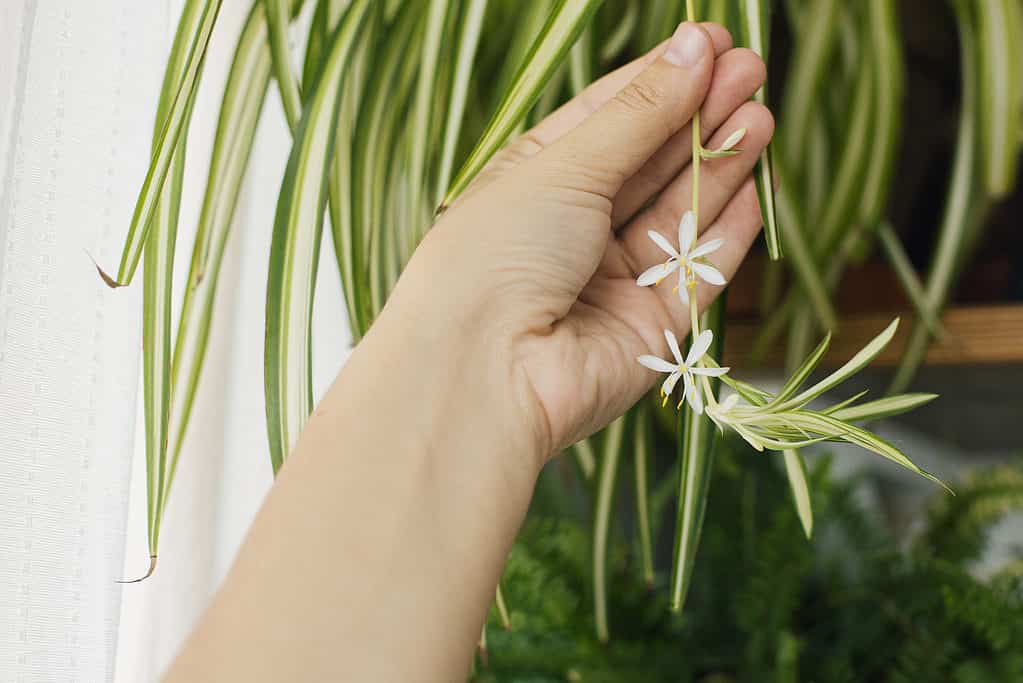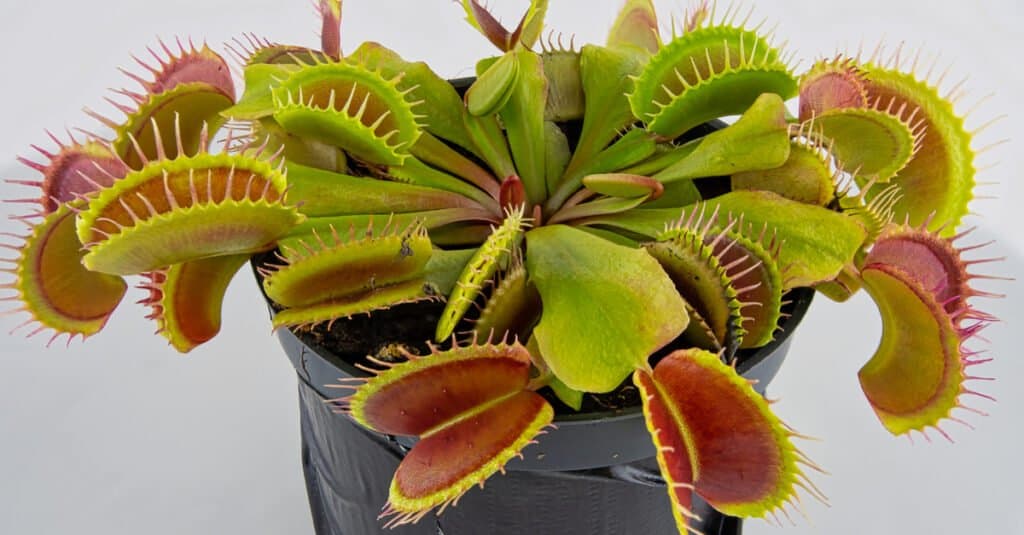Spider plants are a seriously beloved houseplant species. The majority of people choose to cultivate their spider plants indoors simply because they thrive with little fuss. These plants are fantastic additions to any living room or other indoor space since they flourish in a household environment. Because they are robust and tolerant of a wide range of growing situations, spider plants are perfect for beginning gardeners. It is simple to cultivate and enjoy them. Even novice gardeners may easily learn how to care for spider plants.
Low light levels and sporadic irrigation are not a problem for spider plants. They are also quite effective in purifying indoor air, which increases their appeal as houseplants. These plants have the added benefit of being quickly and cheaply reproduced by pruning the tiny spiderettes that emerge from the adult plants’ flower stalks and propagating them. This is an excellent approach to multiplying one mature plant into multiple plants.
Do these plants, however, merit being grown outside? Since spider plants are so well-liked, many people are curious as to whether they may be grown outdoors in gardens. They would be a wonderful addition to any garden, but is it even possible to do so? The good news is that spider plants can be cultivated outside in the proper environments with a little extra care.
In this guide, we’ll break down how to grow and care for a spider plant that is grown outside.
The Benefits of Growing a Spider Plant Outside
Spider plants are excellent plants for novice gardeners since they are surprisingly tolerant of subpar gardening practices and neglect. Many gardeners have at least a few spider plants in their homes in pots or hanging baskets. However, these luscious beauties may be grown in outdoor garden beds or as groundcover by those who reside in warmer climes.
You already know how quickly spider plants grow if you’ve ever had one. Over time, this plant frequently produces plantlets that emerge from the tips of protruding stolons. These tiny spider plants form roots when they contact the earth. Baby spider plants may be removed from the stolons and will develop into separate plants. The young plants can remain tethered to their parents in an outside environment. They merely take root and cover the additional ground with their luscious leaves. Thus, these plants make a great ground cover for large gardens or landscaping projects.

Spider plants (pictured) can thrive in outdoor gardens if they are located in the right hardiness zone.
©iStock.com/Prasenjit Kar
How to Grow a Spider Plant Outdoors
It is not difficult to care for spider plants outside, and your maintenance routine shouldn’t change significantly from that required for interior plants. The most important thing to keep in mind is to give your spider plant enough warmth because it cannot endure cold or frost. New spider plants should be started inside to give the roots time to grow. You should grow your spider plants in slightly acidic, well-draining soil.
Another thing to consider is that in order to grow, spider plants demand filtered sunlight. They may, however, be grown in full shade. That being said, you do not want to expose your spider plant to direct, harsh light, as this can scorch its leaves. Keep this in mind when deciding where to place your spider plants in your garden. The greatest location in a garden for these plants is in dappled shade with bright, indirect light.
Outdoor Spider Plant Growing Tips
These plants tolerate some dryness or lack of humidity. Their deep rhizomes, which store water, protect them from low water circumstances. This does not give you permission to ignore your plant, though. Although you should never let your spider plant sit in water, you should give it regular water.
Young spider plants need moist soil. It is preferable to water them with distilled water or rainfall because they are quite sensitive to the fluoride and chlorine in tap water. Keep in mind that these plants dislike excess fertilizer, but some fertilizing can be beneficial. Use a standard 10-10-10 fertilizer once a month, or perhaps once every two months, for optimal results. Beyond this, you shouldn’t fertilize your plant more than recommended.
You may always dig up your spider plants and place them in pots to bring inside during the winter if you want to grow them outside as annuals. You might gift some plants to relatives and friends if you have too many for your house. They are not overly big and can easily fit in a pot. If you want to cultivate spider plants outdoors and keep them safe over the winter, this is an excellent option.
Ideal Temperatures for Outdoor Spider Plants
It’s vital to grow spider plants outside in USDA hardiness zones 9a to 11b, but if taken indoors during the winter, the plant could potentially thrive in zone eight. Spider plants may withstand temperatures as low as 45 degrees F, but they will be damaged and may not grow. Regular temperatures between 60 and 75 degrees F are preferred by these plants, and they can tolerate heat as high as 90 degrees F, provided there is an abundance of humidity. Avoid areas like the windy corners of your patio or porch where rapid changes in temperature may occur. Bring the plant inside if the outside temperature rises above 90 degrees F to prevent it from overheating and potentially scorching.
Water, Food, and Humidity Needs for Outdoor Spider Plants
During the summer growing season, spider plants only need a small quantity of water, but they thrive when exposed to natural rainfall. Natural rainwater has no fluoride or chlorine, so it is far better for spider plants. Keep them away from areas where water will flow, as beneath non-guttered roof edges. To prevent standing water, ensure the pot or the ground is full of well-draining soil. Ensure the soil is kept just slightly damp during dry or hot spells, then cut back on watering in late fall. In more dry locations where there is less humidity, you should often mist your spider plant with a spray bottle or misting attachment on your hose. If you can grow your spider plant in an outdoor greenhouse, doing so is highly recommended.
Like indoor spider plants, these tiny plants require very little food all year round. When fertilizing, dilute liquid fertilizer for houseplants by half and feed twice a month in the spring and summer. As they are more delicate, avoid fertilizing spiderlings, and refrain from fertilizing even adults during the fall and winter. Granular fertilizer and other choices are effective, but they often don’t function with spider plants as well as the liquid kind does. Ensure the fertilizer you choose has a low boron content and no fluoride, as these can hurt plants.

One can grow a spider plant (pictured) indoors and move it outside during the summer.
©iStock.com/Greenseas
Can I Grow a Spider Plant Indoors and Move It Outside?
Yes, you can. It’s highly recommended, especially if you have unpredictable summers or winters.
That being said, you need to know what type of growth circumstances the spider plant requires if you want to grow it outside in a pot. Despite being a resilient plant that can withstand various situations, it requires warmth to survive.
Remember that South Africa is the natural home of spider plants. These plants are tropical and require a warm environment to survive. They require a tropical climate, which is absent in every climatic zone. USDA hardiness zones nine to eleven are the only ones where spider plants may be cultivated as perennials. However, they can be cultivated as annuals under somewhat cooler temperate conditions.
Keep in mind that these plants cannot withstand any frosts. Wait until all threat of frost has gone before moving them outside if you want to grow them as annuals in colder locations. This is a crucial growth environment that you must offer your plants. Since they can be kept outside during the warmer months and brought inside during the cooler ones, keeping these plants in pots and giving them outdoor “vacations” during certain parts of the year can be a smart move. Because of their propensity to aggressively and swiftly spread in good growing conditions, you should pick a location in your garden where they can do so.
How Big Do Spider Plants Get Outdoors?
Depending on your cultivars or varieties, spider plants come in a wide range of sizes. These plants typically attain a height of 12 to 15 inches, while some cultivars can reach 24 inches. Although they are most known for being left to trickle down from hanging pots, they often spread between a foot and three feet wide on the ground.
The majority of varieties of this plant will develop at a moderate to rapid rate before slowing down as they mature. In contrast, some of the more extensively variegated varieties have a tendency to grow slowly since they lack chlorophyll. The cultivar Chlorophytum comosum ‘Vittatum’ is a superb example of this.
The spider plant’s colorful leaves are lanceolate or linear, eight to eighteen inches long, and approximately half an inch broad. The stems of this plant, with the exception of ‘White Stripe’, are green.
Pests to Watch Out For
Aphids, scale, whiteflies, and spider mites all cause serious damage to outdoor spider plants. These pests can be easily removed using insecticidal soap. Use a spray prepared from a teaspoon of organic dish soap and a quart of water as a less abrasive alternative to insecticide. Neem oil is beneficial for pest-infested outdoor plants as well.

Spider plants do have flowers (pictured), but they lack any sort of fragrance.
©iStock.com/Bogdan Kurylo
Do Spider Plants Have a Fragrance?
Contrary to common opinion, spider plants can blossom. Given the right conditions, they can bloom quite a bit and quite often. The inflorescence varies a little bit depending on the variety or cultivar. Three to six tepals that may be up to an inch long can be seen on the blooms of this plant, which are often white, greenish-white, or yellow in color. Don’t worry if you’re concerned about allergies or bad odors in your yard. The blossoms of the spider plant do not have a fragrance.
Even while the plant has the ability to bloom at any time of the year, it usually does so in the spring or summer, especially when cultivated outside. The discarded blooms will turn into seeds and spiderettes, which may be transplanted after the brief flowering phase.
Spider plants might be a bit difficult to grow outside, especially if you are not in the appropriate hardiness zone. However, with some effort, you can grow a thriving and beautiful spider plant outdoors in your garden, greenhouse, or any other outdoor space.
Do you want to learn even more about the incredible and resilient spider plant? Take a look at our complete guide to spider plants here!
Bonus: What Indoor Houseplants Are Pet-Friendly?

The carnivorous Venus flytrap can help control flies in the home, while also being non-toxic to pets.
©Craig Russell/Shutterstock.com
While we took a look at how to raise a spider plant outdoors, these plants are very popular indoor plants, both for the clean oxygen they create, as well as the fact they are non-toxic, so are an excellent choice to own if you have pets like cats or dogs that enjoy chewing on plants. There are other popular house plants that are equally safe to have around your pets, so are considerations as safe alternatives. Below are 5 plants that are pet-safe.
- African Violets (Saintpaulia)–These flowering plants have been popular in homes for decades due to the lovely flowers they produce, as well as their low maintenance, as they are able to bloom in low light. Best of all, they will not hurt your pets if they decide to take a nibble.
- Chinese Money Plants (Urticaceae)–Popular for their vibrant green, round leaves, these hearty house plants thrive in bright to semi-bright, indirect light, and don’t require frequent watering. They are also non-toxic to pets.
- Banana Tree (Musa spp.)–If you are looking for a larger house plant to fill some empty space, this pet-friendly plant is a perfect choice (and may prove a playful prop for your climbing kitten). They can grow from 2-6 feet tall, depending on the variety, and their leaves are even edible. They do require regular watering and bright sunlight to thrive.
- Venus Flytrap (Dionaea muscipula)–If you’d like to kill two birds with one stone (figuratively speaking), why not bring a Venus flytrap into your home? While posing no threat to the dogs, cats, birds, or other pets you may own, the plant will cut down on your population of flies! Their main requirement is distilled water and bright light to do their job well.
- Boston Fern (Nephrolepis)–If you are a fan of ferns, the Boston Fern will prove a good choice to blend into your household, being safe for pets. Better yet, it does well in low light, and due to the fact it thrives in humidity, these ferns can do well in a bathroom, provided there is some natural light.
The photo featured at the top of this post is © Rezky Bagus Pambudiarso/Shutterstock.com
Sources
- NCSU Staff, Available here: https://plants.ces.ncsu.edu/plants/chlorophytum-comosum/
- Susan Mahr, Available here: https://hort.extension.wisc.edu/articles/spider-plant-chlorophytum-comosum/
- Darcy Larum, Available here: https://www.gardeningknowhow.com/houseplants/spider-plant/growing-spider-plant-outside.htm
FAQs (Frequently Asked Questions)
Can spider plants be grown outdoors?
Spider plants can be grown outdoors as long as they are in USDA hardiness zones nine through 11 and are given partial shade, such as under a tree.
What temperatures can outdoor spider plants tolerate?
Spider plants can endure temperatures from 35 degrees F to 90 degrees F. However, this plant will grow better between 65 degrees F and 90 degrees F.
How long do outdoor spider plants live?
Believe it or not, a thriving outdoor spider plant can live up to 50 years!
Thank you for reading! Have some feedback for us? Contact the AZ Animals editorial team.






